
At Media Shower, we put together monthly progress reports for our clients that show where their website traffic is coming from. As we’ve been exploring their Google Analytics accounts, we’re increasingly seeing a new source of traffic: AI tools.
It’s still only a trickle of visitors, but it’s unmistakable—a new referral source we hadn’t seen a year ago.
Those visitors aren’t coming from traditional search results. They coming from AI tools like ChatGPT, Google Gemini, and Perplexity.
Call it AI search traffic or AI SEO: users are asking AI tools their questions—and sometimes, those tools link directly to your content. AI is not replacing Google Search overnight, but it’s definitely driving more traffic to your website.
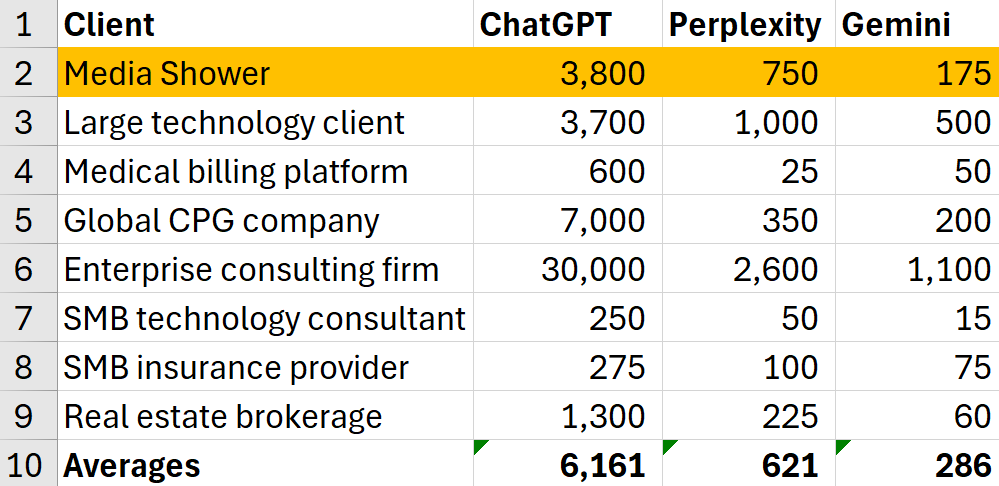
Traffic referred by top AI tools to Media Shower clients (1/1/25 through 7/31/25)
Here’s the challenge: Most analytics platforms don’t have a neat category labeled “AI referrals.” The data is buried, scattered across channels, and often hidden inside existing organic traffic.
Which means if you aren’t looking for it, you’re probably undercounting your AI visitors.
At Media Shower, we’ve worked with over 500 clients of different shapes and sizes, giving us a unique vantage point to measure this shift. We’ve been tracking AI traffic for months, pinpointing patterns and building benchmarks.
What follows is our field report from the front lines of AI-driven traffic—plus a step-by-step guide to measuring your own.
Why AI Traffic Matters for Marketers
The way people find information is changing fast.
Ten years ago, the path was simple: search Google, click a result, read an article. Now, users are skipping the scroll entirely and letting AI do the reading for them—and in many cases, creating a new category of AI traffic analytics that marketers need to track.
When AI decides your content is the most relevant, it will link to you directly. We’ve noticed that those clicks often come from highly qualified visitors. They arrive expecting expertise, not just curiosity.
Right now, most of our clients see AI referrals make up 1–2% of their total traffic. That may not sound like much, but the numbers are growing fast. (Don’t wait until it’s 10% of your visitors, or it’ll be too late.)
From what we’ve tracked, the easiest way to start is to separate AI-driven traffic into two main categories: 1) Google AI Overviews and 2) Standalone AI tools, like ChatGPT, Gemini, and Perplexity.
1) How to Measure Google AI Overview Traffic
If you’ve seen a large AI-generated answer block at the top of Google’s search results, you’ve seen a Google AI Overview, one of the fastest-growing sources of AI-driven traffic measurement opportunities.
These blocks summarize the answer to a query and often include a set of clickable sources.
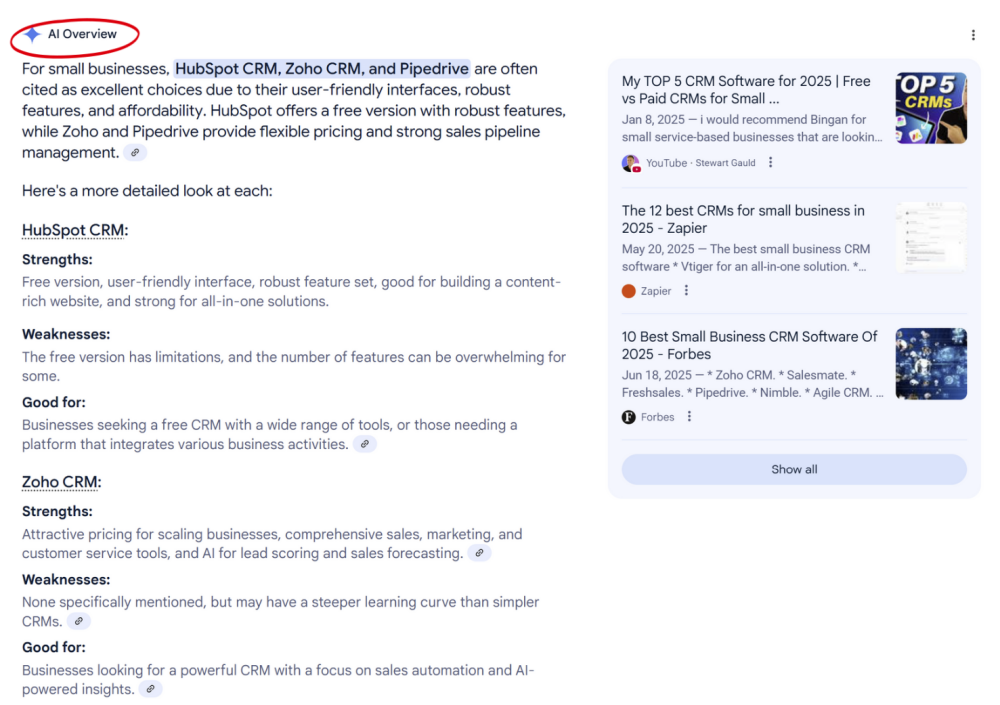
AI Overview for search term “best CRM for small business”
What counts as an AI Overview visit
When a user clicks your link from an AI Overview, that visit will appear in your analytics as google / organic—the same as any other Google search click. The difference is that the click came from inside the AI summary, not from the standard list of results.
We see this most often with clients who have long-form, detailed, evergreen content. AI Overviews tend to favor pages that answer a question comprehensively and cleanly, without forcing the reader to wade through unrelated material.
How to identify your AI Overview keywords
You can’t see AI Overview clicks directly in Google Analytics, but you can spot the keywords that trigger these summaries using tools like the Ahrefs Organic Keywords report (note: requires subscription).
The quick version:
- Run an Organic Keywords report for your site.
- Export the data to a CSV file.
- Sort or filter the “SERPs” column to only show keywords containing the phrase “AI Overview.”
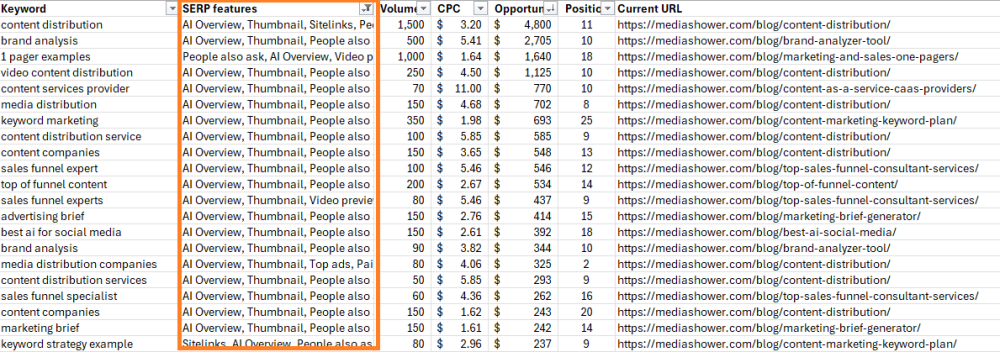
When we run this process for clients, we often uncover a small set of keywords that consistently appear in AI Overviews. Those become our “priority watchlist” for content optimization, because even a slight ranking improvement there can mean more AI exposure.
We also analyze these pages to find out what’s working: If these pages are showing up consistently in AI Overviews, then what kind of content do they have? How is it structured? How long are they? This helps inform all our content efforts.
Keeping an eye on these shifts alongside your AI Overview keywords can give you an early signal of emerging visibility opportunities.
What you can and can’t measure directly
You can measure direct referrals from gemini.google.com, which comes from users who start their search in Google’s Gemini AI assistant (i.e., they start on gemini.google.com).
But you can’t measure traffic that comes through Google AI overviews, because that’s mixed in with all your google.com referral traffic (i.e., it’s all just Google referral traffic).
So track gemini.google.com, but keep in mind it’s just the tip of the iceberg. The bulk of AI Overview traffic hides under regular Google organic referrals.
2) How to Measure Standalone AI Tool Traffic
Standalone AI assistants like ChatGPT, Perplexity, and Claude are starting to send measurable traffic, what we call AI referral traffic, which you can track directly in Google Analytics. Because this traffic comes from a discrete domain (like ChatGPT.com), GA4 can give you clean, direct numbers.
Here’s how we handle referral tracking in GA4:
- Go to Acquisition > Traffic acquisition.
- Change the dropdown above the “Total” column to Session source/medium.
- Use the search box to filter by the AI tool name (“ChatGPT,” “Perplexity,” or “Gemini”).
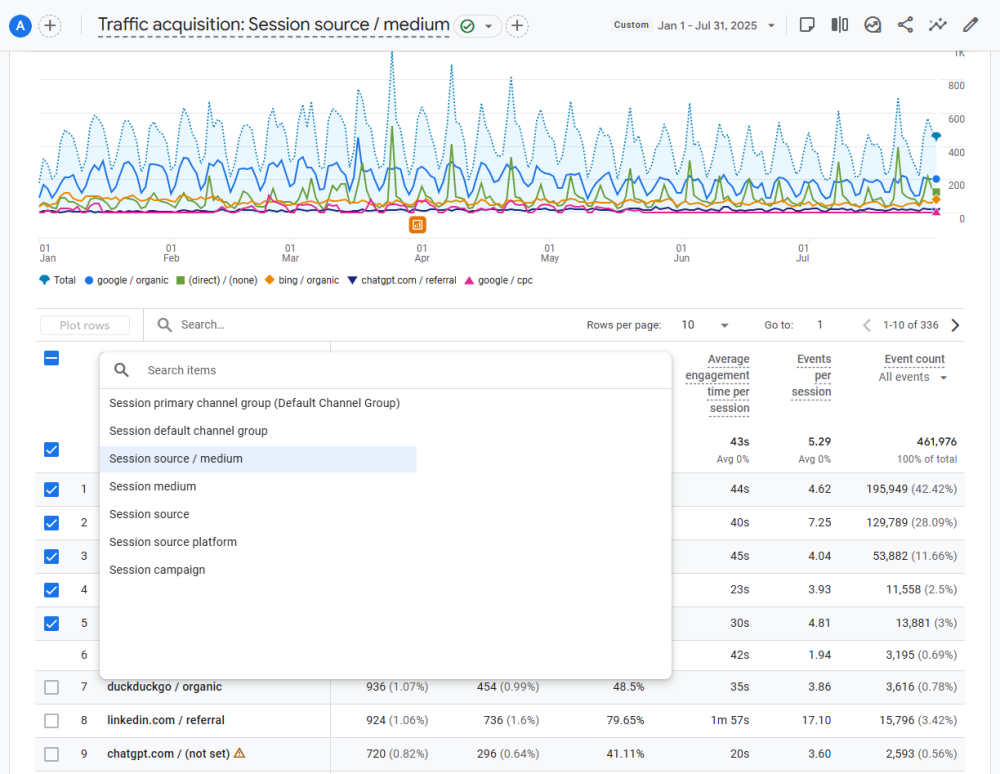
From January to June 2025, here’s what our data shows:
- ChatGPT sent Media Shower 4,000 users. Our largest client saw 30,000. The average client saw about 5,800.
- Perplexity sent Media Shower 750 users. Our largest client saw 2,600. The average client saw about 650.
- Gemini sent Media Shower 180 users. Our largest client saw 1,000. The average client saw about 280.
The following screenshots come directly from Media Shower’s own GA4 dashboards for the period January 1 through July 31.
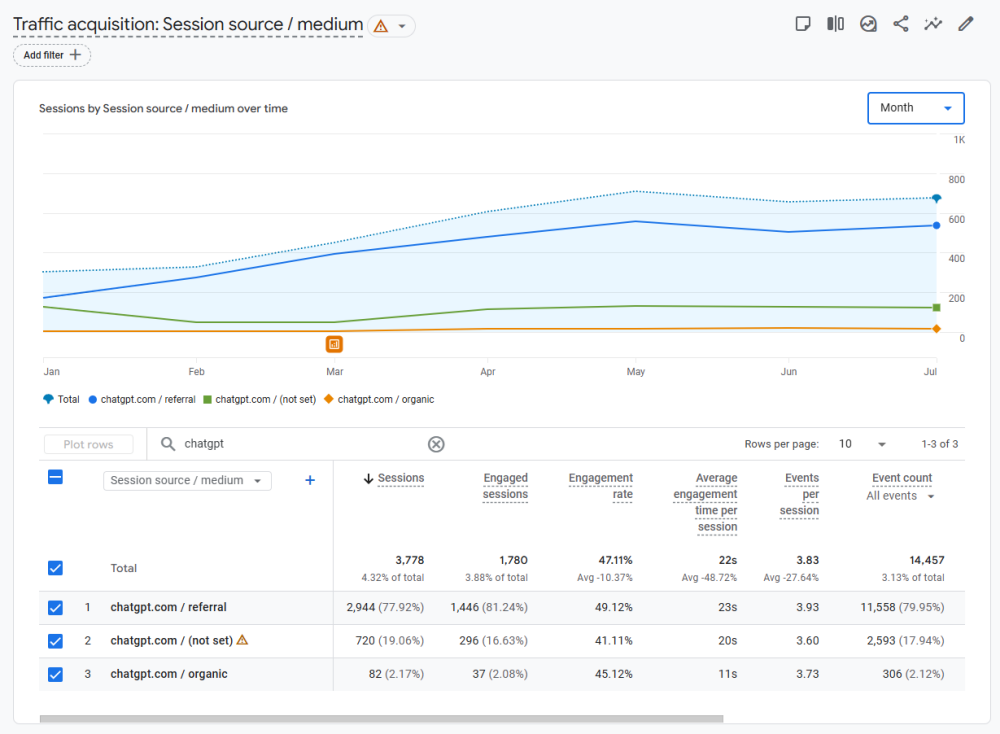
GA4 Traffic Acquisition report filtered for ChatGPT referrals (note increase in traffic).
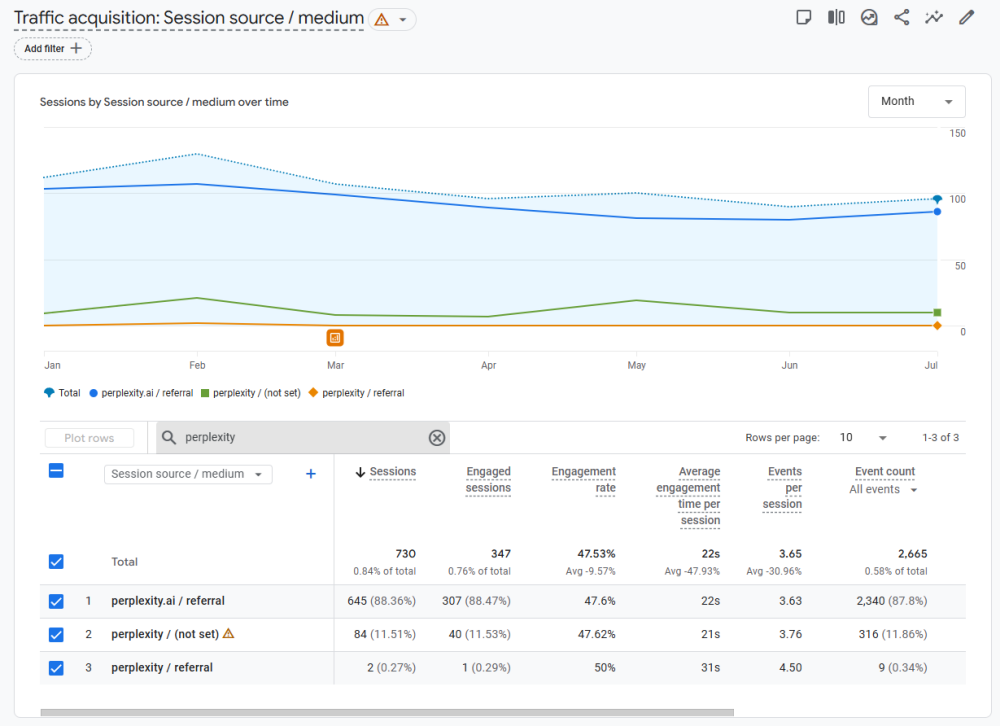
GA4 Traffic Acquisition report filtered for Perplexity referrals.
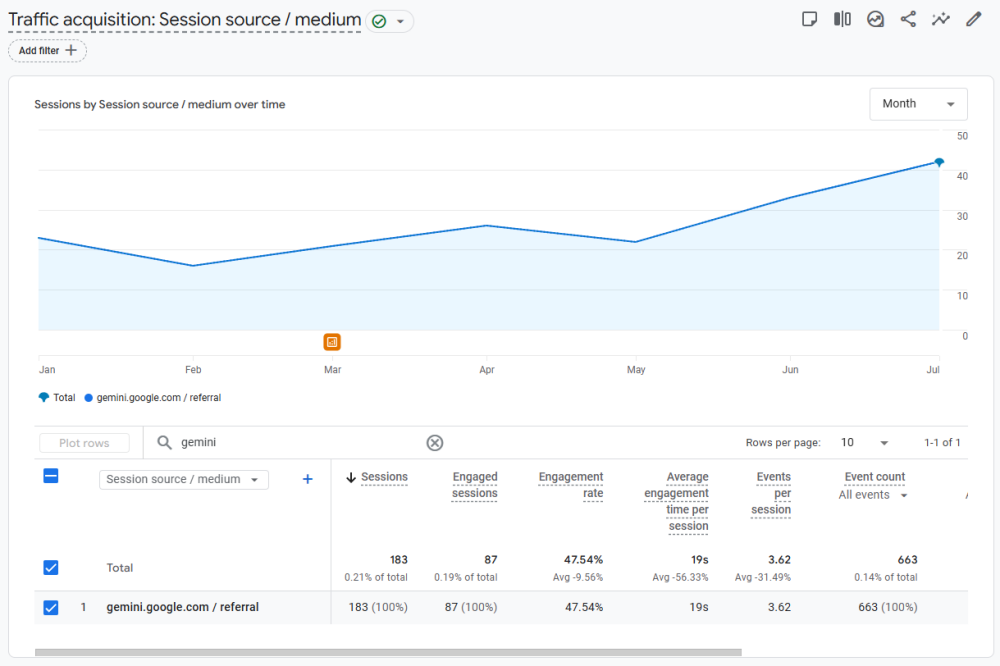
GA4 Traffic Acquisition report filtered for Gemini referrals.
Key Takeaways: ChatGPT tends to send higher bursts of traffic around content that’s well-structured, with keyword-focused subheads and FAQs. Perplexity referrals skew toward niche or specialized topics, while Gemini’s numbers are still small but growing.
3) How to See Which Pages Win AI Referrals
Knowing how much traffic AI tools send is helpful. Knowing which pages are attracting AI traffic is where you can take action.
Here’s how to do it in GA4:
- In the same “Traffic acquisition” report, click the “+” next to Session source/medium.
- Select Page / screen > Landing page + query string.
- Filter by the AI tool name (e.g., “ChatGPT”).
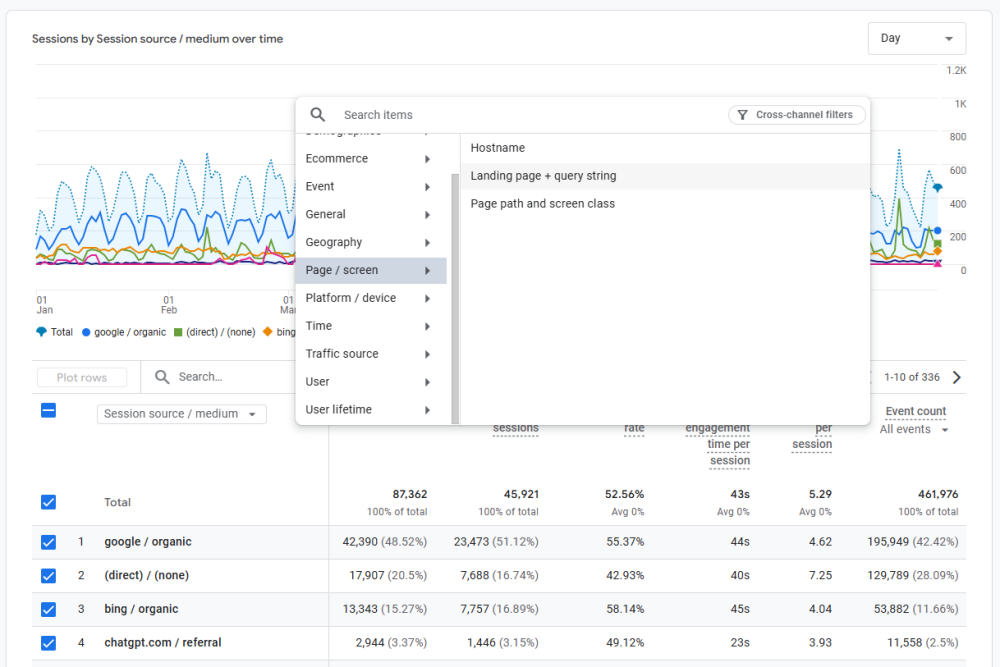
When we run this report, we often see a few “surprise winner” pages that perform especially well, even if they weren’t top performers in traditional search.
Those surprises tell us something important: AI SEO can differ from traditional SEO.
Once we identify those AI-linked pages, we treat them like premium real estate. We refresh the content, add internal links, and make sure they have clear calls to action, because AI visitors are generally better prospects, and often ready to take the next step.
How to Turn AI Traffic Insights Into Strategy
Once you know which AI tools are sending you traffic and which pages they favor, you can start shaping content for this new search environment.
For clients, we often begin by deepening the authority of their top AI-linked pages. That might mean expanding sections with updated statistics, embedding explainer videos, or adding expert commentary to increase credibility.
We also look for content gaps. By comparing our clients’ AI-linked keywords to competitor citations, we can pinpoint topics where they’re absent from AI answers. That becomes a shortlist for new content creation.
We’ve found it’s worth testing different formats as well. In our data, Perplexity tends to favor step-by-step guides, ChatGPT often links to comprehensive explainers, and Gemini sometimes prefers concise reference pages. By matching the format to the AI tool’s tendencies, we’ve been able to nudge referral numbers upward.
The Road Ahead
Across our client base, AI-driven traffic currently accounts for about 1% of total visitors, with top performers reaching 2%. Those numbers may seem small, but the growth curve suggests this slice will expand quickly.
As you can see from the charts above, the upward trend is already visible across multiple client accounts, and quarter-over-quarter growth is accelerating.
By tracking AI referrals now, you put yourself ahead of the curve. You’ll know which content is already making the cut and which areas need improvement. And when AI-driven discovery becomes a larger share of your inbound traffic, you’ll be ready.

Marketer Takeaways
From tracking dozens of client accounts over the past six months, we’ve seen a few trends emerge:
- Early adopters have an advantage. The brands that started monitoring AI referrals months ago are already optimizing the right pages and seeing faster growth in AI-driven traffic.
- Authority matters more than keyword stuffing. AI tools seem to value depth, clarity, and trust signals over aggressive keyword targeting. Our highest AI-referral pages often have the cleanest, most comprehensive answers.
- Different tools favor different formats. ChatGPT likes in-depth explainers, Perplexity leans toward structured guides, and Gemini often cites short, factual reference pages.
- Small wins add up quickly. Even a handful of new AI citations can mean hundreds—or thousands—of additional visitors when multiplied across many queries.
- AI traffic is rising faster than expected. In multiple industries, AI referrals doubled from Q1 to Q2 of 2025. We expect that curve to steepen.
Media Shower’s AI marketing platform helps you capture AI referrals before your competitors do. Click here for a free trial.


